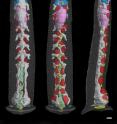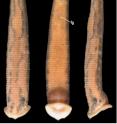Tiny Australian leech named for best-selling author Amy Tan
Researchers have named a new leech after best-selling author Amy Tan based on an innovative method for peering inside soft-bodied animals. Chtonobdella tanae, a terrestrial leech from Australia, is the first new species of invertebrate without chitinous or calcified tissues (like a shell or exoskeleton) to be described with computed tomography (CT) scanning. The work was recently published in the journal Zoologica Scripta, and opens possibilities for non-destructively studying soft-bodied organisms, a group of animals ranging from worms to jellyfish that represent a huge part of the tree of life. "Historically, to get an idea of what the internal structure of a soft-bodied invertebrate looks like, you have to dissect it by hand or painstakingly section the specimen and then reconstruct it in three dimensions," said Michael Tessler, lead author on the paper and a student in the comparative biology doctoral program at the American Museum of Natural History's Richard Gilder Graduate School. "CT imaging is not only more precise than physical dissection, but it also doesn't require us to discard the specimen we're studying."
Like those found in medical offices, CT scanners used for scientific research take thousands of cross-sectional x-ray "slices" of a rotating object to digitally produce a 3D view of its interior. As the x-ray beam passes through the object, different tissues or materials absorb different amounts of x-rays. Detectors on the opposite side pick up the x- rays that travel through the object and create a contrast image based on the density of the internal components. As with all x-ray techniques, dense structures like bone are easily imaged, whereas soft tissues are less able to stop x-rays, making them difficult to image. So while researchers who study things like dinosaur skulls, anthropological artifacts, meteorites, and lizards, among many other specimens, have benefited from CT technology for the last decade or so, those who examine soft-bodied organisms continue to rely principally on traditional dissection techniques to look inside of their specimens.
With the goal of making the tissues in soft-bodied animals show more contrast in CT scans, the researchers examined a variety of fixatives, chemicals that preserve biological tissues from decay. They tested the effect of the following fixatives on a common freshwater North American leech, Macrobdella decora: ethanol; glutaraldehyde; a combination of alcohol, formalin, and acetic acid called AFA; and osmium tetroxide. These tests revealed that the best way to enhance contrast in the CT image is to fix the leech in AFA and then refix it in osmium tetroxide, which binds the heavy metal osmium to the internal tissues.
"We were able to resolve the external and internal anatomy at very high resolution," said senior author Mark Siddall, a curator in the Museum's Division of Invertebrate Zoology. "In addition, we were able to see internal structures we might not have otherwise seen because of the disruptive influence of cutting things open."
The researchers then used this fixative combination to CT scan and describe a new species of leech from Queensland, Australia, which, at about 1 centimeter long and 2 millimeters wide, is too small to dissect. The leech was given the name Chtonobdella tanae in recognition of Amy Tan, author of the best-selling novel The Joy Luck Club and other works, who has accompanied Siddall's lab into the field.
"Amy, long a supporter of the work we do here, is someone we knew would consider it an honor, not an insult, to have a leech named for her," said Siddall. "These jungle leeches are mentioned several times in her hilarious novel Saving Fish from Drowning."
"I am thrilled to be immortalized as Chtonobdella tanae," Tan said. "This humble leech has looped across a new scientific threshold--the first microscopic soft-bodied critter to be described inside and out using CT scanning. Imagine the possibilities for identifying legions of tiny organisms that have thus far lived in obscurity. I am now planning my trip to Queensland, Australia, where I hope to take leisurely walks through the jungle, accompanied by a dozen or so of my namesake feeding on my ankles."
As part of this work, the researchers also revised the genus Chtonobdella to include all two-jawed leech species, which were previously distributed in 31 genera.
Source: American Museum of Natural History
Other sources
- New Australian leech species named for best-selling author Amy Tanfrom UPIThu, 21 Jan 2016, 22:40:36 UTC
- Tiny Australian leech named for best-selling author Amy Tanfrom Science DailyThu, 21 Jan 2016, 21:04:20 UTC
- Tiny Australian leech named for best-selling author Amy Tanfrom PhysorgThu, 21 Jan 2016, 18:44:41 UTC

